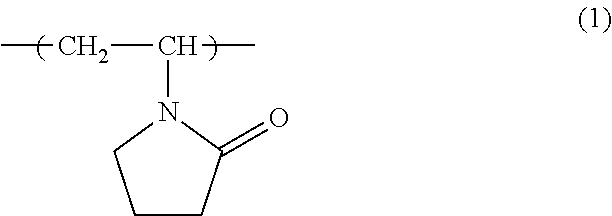Water-soluble packaging film
a packaging film and water-soluble technology, applied in the field of water-soluble packaging films, can solve the problems of low water solubility of pva, disadvantageous high hygroscopicity to have insufficient elasticity, and insufficient removal of pva, so as to improve productivity, improve process passing properties, and facilitate unwinding.
- Summary
- Abstract
- Description
- Claims
- Application Information
AI Technical Summary
Benefits of technology
Problems solved by technology
Method used
Image
Examples
example 1
[0093]An amount of 90 parts by weight of pyrrolidone ring-modified polyvinyl alcohol (polymerization degree: 1000, saponification degree: 95.8 mol %, standard deviation of saponification degree distribution: 0.21 mol %, modification amount with pyrrolidone ring: 4 mol %, viscosity of 4% by weight aqueous solution: 10 mPa·s) having a structure unit represented by the formula (1) as polyvinyl alcohol, and 5.0 parts by weight of glycerin (Wako Pure Chemical Industries, Ltd.) and 5.0 parts by weight of trimethylolpropane (Wako Pure Chemical Industries, Ltd.) as plasticizers were dissolved in 667 parts by weight of water to prepare a 15% by weight aqueous solution.
[0094]The standard deviation of saponification degree distribution of the polyvinyl alcohol was measured as follows.
(Measurement of Standard Deviation of Saponification Degree Distribution)
[0095]Forty polyvinyl alcohol particles were randomly selected, and the acetyl group content of the polyvinyl alcohol was measured with a FT...
example 2
[0097]An amount of 95.1 parts by weight of unmodified polyvinyl alcohol (polymerization degree: 1300, saponification degree: 88.0 mol %, standard deviation of saponification degree distribution: 0.73 mol %, viscosity of 4% by weight aqueous solution: 14 mPa·s) as polyvinyl alcohol, and 3.3 parts by weight of glycerin (Wako Pure Chemical Industries, Ltd.), 0.8 parts by weight of trimethylolpropane (Wako Pure Chemical Industries, Ltd.), and 0.8 parts by weight of Polyethylene Glycol 600 (Wako Pure Chemical Industries, Ltd.) as plasticizers were dissolved in 667 parts by weight of water to prepare a 15% by weight aqueous solution.
[0098]A wound body of a laminate film including a PVA film (thickness: 50 μm) was produced in the same manner as in Example 1. The support member was peeled off from the obtained wound body of a laminated film to prepare a PVA film. A water-soluble packaging film was obtained in the same manner as in Example 1 by applying starch derived from corn (average part...
example 3
[0099]A water-soluble packaging film was prepared in the same manner as in Example 1, except that the polyvinyl alcohol used was sodium sulfonate-modified polyvinyl alcohol A (polymerization degree: 1200, saponification degree: 95.4 mol %, standard deviation of saponification degree distribution: 0.31 mol %, modification amount with sulfonic acid group: 4 mol %, viscosity of 4% by weight aqueous solution: 12 mPa·s) having a structure unit represented by the formula (2) in which R1 represents a 2-methylenepropylene group, and that starch derived from corn (average particle size: 20 μm) was applied in an amount of 0.01 g per 1 m2 of the water-soluble packaging film.
PUM
| Property | Measurement | Unit |
|---|---|---|
| contact angle | aaaaa | aaaaa |
| viscosity | aaaaa | aaaaa |
| viscosity | aaaaa | aaaaa |
Abstract
Description
Claims
Application Information
 Login to View More
Login to View More - R&D
- Intellectual Property
- Life Sciences
- Materials
- Tech Scout
- Unparalleled Data Quality
- Higher Quality Content
- 60% Fewer Hallucinations
Browse by: Latest US Patents, China's latest patents, Technical Efficacy Thesaurus, Application Domain, Technology Topic, Popular Technical Reports.
© 2025 PatSnap. All rights reserved.Legal|Privacy policy|Modern Slavery Act Transparency Statement|Sitemap|About US| Contact US: help@patsnap.com



